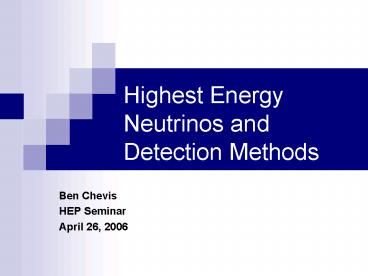Highest Energy Neutrinos and Detection Methods - PowerPoint PPT Presentation
1 / 20
Title:
Highest Energy Neutrinos and Detection Methods
Description:
Greisen-Zatsepin-Kuzmin(GZK) Limit. Cosmic rays with energies above 5 1019 eV will interact with the cosmic ... This process would continue until the energy of ... – PowerPoint PPT presentation
Number of Views:40
Avg rating:3.0/5.0
Title: Highest Energy Neutrinos and Detection Methods
1
Highest Energy Neutrinos and Detection Methods
- Ben Chevis
- HEP Seminar
- April 26, 2006
2
Neutrino Sources
- M. Spiro D. Vignaud, Nucl Phys A654 1999 350c
3
Greisen-Zatsepin-Kuzmin(GZK) Limit
- Cosmic rays with energies above 51019 eV will
interact with the cosmic microwave background
photons to produce pions. This process would
continue until the energy of the cosmic ray fell
below the pion production threshold. - However the AGASA (Akeno Giant Air Shower Array)
experiment found cosmic rays above this limit.
Possible explanations - 1. Instrument error or incorrect interpretation
of the data - 2. Local source of the cosmic rays
- 3. Ultra High energy neutrinos created at great
distances and later reacting locally
4
GZK Neutrinos
- Two possibilities
- Cosmic rays above the GZK limit will interact
with the CMB and can produce ultra high energy
neutrinos - The ultra high energy cosmic neutrino emitted
from the far-away sources barely interact with
the 3k photons avoiding the energy loss by the
GZK mechanism, but might later collide with the
relic neutrinos to initiate the neutrino
cascades.
- Images by Shigeru Yoshida, Chiba University
5
Example of detector currently being built
IceCube
- 1 km3 detector area
- Designed to detect 107 1020 eV neutrinos
- Expect 0.2 40 GZK neutrinos per year (1/1000 of
primary neutrino intensity)
6
Problems with IceCube and GZK neutrinos
7
Detection Methods
optical Cerenkov
- Super Optical Cerenkov Detectors
- Radio Cerenkov Detectors
- Air Shower Radio Signals
- Acoustic Detectors
radio Cerenkov
acoustic
incoming neutrino
8
Super Optical Cerenkov Detectors
- At energies gt1018 eV neutrino induced showers and
muons produce so much cerenkov radiation that
photo-multiplier tubes of current detectors are
triggered over several hundred meters. Examples - To fix this the distance between PMTs would need
to be increased. - There is a proposal to add an outer ring to the
IceCube detector. IceCube-Plus would be 300 500
m from the outer most strings with 13 18
strings.
100 GeV ? 20m 1 PeV ? 400m 1 EeV ? 600 - 700m
9
Radio Cerenkov Detectors
- It was suggested by Askaryan in 1962 that any
electromagnetic cascade in a dielectric material
(gas, liquid or solid) should rapidly develop net
negative charge asymmetry due to electron
scattering processes and positron annihilation
which will create Cerenkov radiation
10
Radio Cerenkov Detectors
- RICE (Radio Ice Cerenkov Experiment)
- radio receivers placed in the holes drilled for
the AMANDA optical modules - GLUE (Goldstone Lunar Ultra high energy neutrino
Experiment) - two radio antennas looking for radio signals
produced by neutrinos passing through the moon - FORTE (Fast Orbit Radio Transient Experiment)
- satellite searching for radio signals from
Greenland ice - ANITA (Antarctic Impulsive Transient Antenna)
- balloon mounted detector searching for radio
signals from Antarctic ice - SalSA (Saltdome Shower Array)
- large salt dome used as detector medium
11
Air Shower Radio Signals
Flys Eye
- The deflection of electron positron pairs in the
earths magnetic field produce radio signals from
air showers. - The frequencies are expected to be as low as a
few hundred MHz
12
Air Shower Radio Signals
- LOPES (LOfar PrototypE Station) attached to
KASCADE/GRANDE AUGER (Karlsruhe Shower Core and
DEtector) - pyramid shaped radio antennae
- CODALEMA (Cosmic ray Detection Array with
Logarithmic ElectroMagnetic Antennas) - conical radio antennae array
13
Acoustic Detectors
- The energy produced by particle cascades in a
small volume of matter during a short time will
overheat that volume, leading to a pressure
pulse. The amplitude of this pulse measures the
cascade energy. - The frequency of the pulse is estimated to be
10-100 kHz - The detection media is most often water but ice
and salt are being studied.
14
Acoustic Detectors
- SAUND (Study of Acoustic Ultrahigh-energy
Neutrino Detection) - hydrophones located near the Bahamas
- Salt Dome
- Acoustic waves in the Hockley salt mine in Texas
15
Comparison of Radio, Acoustic and Optical Cascades
- Dr. P. Buford Price
16
Conclusion
- Though the techniques for all of the shown
experiments are more than thirty years old,
recent technological advances have revived them
as possible neutrino detectors. Expect to hear
more about them.
GLUE
Hydrophone at ITEP
ANITA
FORTE
SAUND
Acoustic detector at DESY
SalSA
17
Fin
18
References
- This presentation is largely based on a paper by
Rolf Nahnhauer, astro-ph/0411715, Alternative
Detection Methods for Highest Energy Neutrinos - Also work by Shigeru Yoshida, Chiba University
and David Waters of University College London
were very helpful
19
Extra slides
20
(No Transcript)

